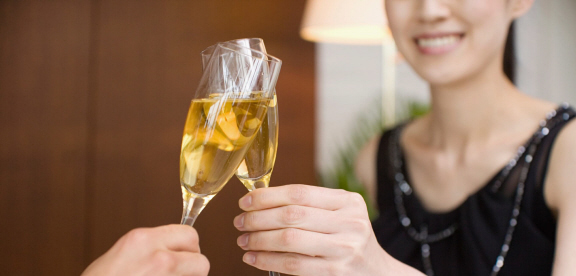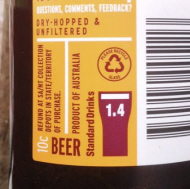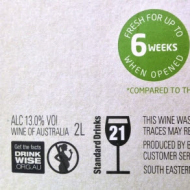Alcohol: 26 tips to stay on top of your favourite drop
26 easy tips about alcohol
Whether you crack open a bottle, can or cask, alcohol promises to deliver ups and downs.
Rather than be a petty party-pooper, I want to share 26 easy tips for being smarter with alcohol.

Tips to help you stay on top of your favourite drop.
Tips that show how you can still enjoy it, reduce your life-time risk of coming to harm from it, and maybe even gain some benefits.
First you need to know a few important numbers. The number of standard drinks to drink in a single day.
important numbers
1 or 2
no more than 4
be sure to check the pour
why?
Less than four drinks in a single session reduces the risk of harm from alcohol-related injury: falls, fights, foolish pranking, risky road crossing, doubtful decisions ... you get the idea.
Any more than four standard drinks in a 24-hour period is too much and carries more risk to the drinker, both in the short-term and over a lifetime.
Two standard drinks on any day is the level at which life-time risk of harm from alcohol-related disease and injuries remains low.
But as far as your heart health goes, less is better.
Up to two standard drinks per day for men and up to one standard drink for women may reduce risk of cardiovascular disease (heart and blood vessel disease). Drink more than these and the potential benefits are lost.
If you are pregnant, trying to get pregnant, or breastfeeding, it really is safest not to drink any alcohol at all.
check the pour
A standard drink is rarely the same as what you pour into a glass or the amount you get served at a pub, club, restaurant or party.
What’s a standard drink? You’ll find the number of standard drinks on bottles, cans and casks. It’s the law. With the label to hand, it is easy to plan and track how many standard drinks you consume. Check the label before you have your next drink.
When out and about, it is harder because there is no Australian law or requirement for licensed premises to serve you a standard drink of beer or wine.
Beer drinkers will know the volume of beer (in mls) served because the volume is defined at a plimsol line on the glass but this doesn’t have to match a standard drink. For wine, there is no legal requirement to sell by a set measure.
You won’t find a plimsol line on all wine glasses. Usually the pour is more than a standard drink. If you drink spirits, you’re in luck because the legal serve for spirits is defined and matches a standard drink.
It’s also very hard to guess the volume a glass holds.
Check your guessing skills at home.
Pull out a variety of different sized and shaped glasses. Pour water into each and every glass up to the level you think matches a standard serve of your favourite drop. Now tip the water from a single glass into a measuring jug. Write down the result. Empty the jug between each check.
How close is your pour to the standard drink targets below?
| alcoholic drink |
one standard drink (contains about 10 g or 12.5 ml alcohol) |
|
full strength beer or cider (4.8% alc vol) |
278 ml |
|
mid strength beer (3.5% alc vol) |
375 ml |
|
wine, red or white (11.5 - 13.5% alc vol) |
100 ml |
|
spirits (40% alc vol) |
30 ml |
|
liqueurs and fortified wine such as port and sherry (16 - 18% alc vol) |
60 ml |
* A standard drink contains 10 g alcohol (12.5 ml alcohol). The numbers on casks, cans and bottles vary a little due to the pure alcohol content of the drink.
how to better manage your alcohol intake
tips to use at home:
1. Explore the bottle, can or cask to discover how many standard drinks are present.
2. Check the size of your glasses to know how much you pour. It is not reliable to guess. Select a glass that holds 100 ml for table wine. A smaller 60 ml glass fortified wine such as port and sherry.
3. Offer water (sparkling, mineral, soda or tap) as a genuine choice at dinner and get-togethers. Make it easy and okay for anyone to choose not to drink alcohol.
4. Invest in a jigger or nip pourer to manage spirits.
5. Pour a fresh glass for each drink and stack the empties (bottles and glasses) in front of you to keep track of how many you’ve drunk. Evidence doesn’t lie.
6. Attend wine and beer appreciation classes to become a slower, more appreciative and discerning drinker rather than quaffer. Old cellared bottles won’t show the number of standard drinks on the label.
7. Cancel that wine subscription. It quite likely triggers you to drink more just to keep up with deliveries.
8. Give away the home brew kit if stockpiles of brew are too tempting.
9. De-stress and relax after a hectic day with something other than alcohol. Trade the tipple for tea, shed the stress with a soaking shower, wind down with a walk or tune out from stressful stimuli for ten minutes.
10. Use the number of standard drinks on the cask, carton or bottle to work out the least number of days the container should last.
- If your goal is a healthy body shape or you are partial to a few other red-alert foods (such as chocolate, lollies, cake and chips), extend the life of a cask of wine or bottle of spirits to many, many more days. Once opened, a cask lasts up to 6 weeks so there’s no need to rush. Check the label on your cask to reveal the shelf life. Or make that slab of IPA or beer go further.
- You choose. There’s room for either alcohol or other red-alert red extras (some call them discretionary foods), not both as far as a healthier body is concerned.

The bottle of IPA contains 1.4 standard drinks. One or two bottles sits under the top limit in the mantra "1 or 2, no more than 4". After a healthier body? Settle at one bottle with no other alcoholic drinks.

This cask of wine ?
21 standard drinks. Drink one standard drink a day to make it last at least 21 days. Drink up to two standard drinks a day and it will go in 11 days.
tips for out and about social drinking
11. Avoid entering ‘rounds or shouts’ unless you are confident and comfortable to ask for non-alcoholic drinks.
12. Be the designated driver - a very valid reason not to drink any alcohol.
13. Alternate alcoholic drinks with soft options such as tap or soda water or juice.
14. Take drinks with a lower alcohol content to BYO events.
15. Refill your small empty cider, beer or alcopop bottle with tap water. No-one will notice especially if the bottle is coloured.
16. Choose not to drink alcohol. Take sparkling water instead. It is also fine to drink tap water and low joule drinks.
17. Rehearse the words: ‘no thanks’, ‘no more’. If saying no to the first drink is not acceptable, drink slowly and refuse top-ups.
18. When someone sees your empty hand and asks if you are okay for a drink, quickly reply "I’m good thanks. I put my drink down and am just going to look for it’.
19. Create and rehearse a believable reason not to drink so much (or at all) if ‘no thanks’ is not powerful enough for the company you keep:
- Too much alcohol’s been upsetting me recently. I don’t feel well after drinking. Or, I get (choose a symptom such as one of these) ... headaches ... gastritis ... rash ... flushing ... heartburn ...
- I’ve just discovered I am intolerant to beer/wine/spirits (or whatever is your usual drop).
- The doctor said I need to cut back because I’ve got a fatty liver and alcohol knocks the liver about.
- I’ve had a few too many big nights lately and need a break from drinking.
tips for social relaxers
20. Start with one drink to relax, break the ice and gain social confidence. You won’t need much more after that when others around you are drinking because their memories and social recall will quickly drop. For some people, alcohol increases the risk of depression and anxiety so be on the lookout for these signs and seek psychological advice to better manage social outings, phobias and anxieties.
21. Arm yourself with more social tools: opinions about hot topics, listening skills, tales about your interests, stories from recent travels ...
When weight loss is your goal:
22. A busier social (and so drinking) calendar will partly explain weight stalls and plateaus.
23. Keep a firm check on how much and how often your drink alcohol. You may need to change the pattern to balance out events that add more alcohol to your life.
- The more you drink, the slower your results will be. It’s all about the total kilojoules consumed. Alcohol adds more kilojoules to your day.
- One small glass (100 ml) of wine per day (or a bottle of wine per week) could prevent you from losing an extra 3 kg per year.
- Just 4 stubbies of beer per week (about 1.6 litres) has the same slow down effect.
The bigger picture?
24. Never save up your daily serves for a big drinking session or binge. It is not recommended. Over four drinks at a time is risky drinking.
25. Take the challenge to free yourself from alcohol for a month or at least have have a few alcohol free days (AFD) each week. Why wait for Dry July to reset your drinking habits? Create your own Fab Feb, Recharge in March ... make November and December Good to Remember.
26. Stay focussed. Alcohol distorts your judgement. After one or two drinks, it is harder to stay focused to make rational, intelligent choices (around food and life) and keep to your drinking plan.
What is the bad news?
Surprisingly, any amount of alcohol, not just excess, comes with a risk and is harmful. There is no safe level of alcohol intake.
Alcohol is harmful stuff. Any amount is harmful and the more you drink, the more risk of harm. And it’s not just harm from horrid hangovers and doubtful decisions. It’s harm related to ill-health, injuries, and risk of developing cancer, specifically breast cancer, colorectal cancer, and head and neck cancer.
If it is not unusual for you to drink four or more standard drinks in any single day, read the tips again and apply them. Seek professional assistance if you find it hard to shake the routine and habit. Your body and mind will appreciate a lower alcohol load.
Alcohol’s bad side really outweighs its potential for benefit when you drink more than the guidelines shown above. You can only reduce your risk of harm by limiting how much you drink. More than four standard drinks in a day is far, far too much. Too much alcohol is not good.
Alcohol is not a nutrient. Alcohol is not essential for good physical health. Alcohol is a discretionary red-alert item. Make a smart choice about how many non-essential foods and drinks fuel your body. The kilojoules in alcoholic drinks quickly add to your daily intake; once you’ve consumed too many kilojoules in total you start to store body fat. Alcohol may displace other essential foods.
Some medical conditions put alcohol off the menu entirely. The advice of your own dietitian and doctor will guide you. For example, zero alcohol is recommended for the person with liver disease, fatty liver or NASH (nonalcoholic steatohepatitis).
Some medications also put alcohol off the menu. The interaction between alcohol and medications is complex and may change in the way your body absorbs and metabolises the medication, cause drowsiness, increase the action and side-effects of the medication or render the medication useless. Speak with your pharmacist and doctor if you are uncertain or the medication label is not clear.
Resources:
National Health & Medical Research Council 2009 Australian Guidelines to Reduce Health Risks from Drinking Alcohol (under revision at Aug 2017, update expected early 2019)
National Measurement Unit Trade Measurement 2010 Guide to the sale of Alcohol
© reviewed 2018, updated 2017, original 2015 by Trudy Williams, dietitian and director of foodtalk
